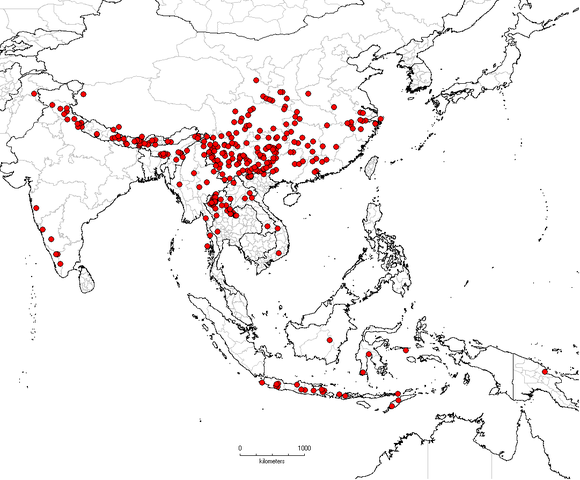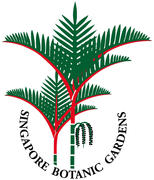Nomenclature
Dinetus racemosus (Roxb.) Buch.-Ham. ex Sweet, Brit. fl. gard. 2: tab. 127. [1 Oct.] 1825.
Dinetus racemosus
Porana cordifolia Ledeb., Indicis Seminum Horti Academici Dorpatensis, suppl. 2: 6. [6 Dec.] 1824. TYPE: Estonia. [Tartu:] cultivated in hort. bot. Dorpat, Herb. Ledebour s.n. (lectotype: LE; isolectotypes: LE, W).
Porana racemosa J. Jacq. in Sprengel, Syst. Veg. ed. 16, 1: 614. 1825 [late 1824] non Roxb. (Mar-June 1824). Type: Nepal. Wallich Cat. 1326 (lectotype: W; isolectotypes: LE, S, W).
Porana dichotoma Buch.-Ham. ex D. Don, Prodr. fl. nepal. 99. [1 Jan.-1 Feb.] 1825, invalid under Art. 34.
Porana elegans Zoll. in Zollinger & Moritzi, Natuur-Geneesk. Arch. Ned.-Indië 2: 571. 1844. TYPE: [Indonesia.] Java: in montosis Tengger, pr. Poespo, Oct. 1844, Zollinger distr. 2560 (lectotype: A; isolectotypes: BM, G, LE, P).
Porana gagnepainiana H. Lév., Cat. pl. Yun-Nan 58. 1916. TYPE: China. Yunnan: haies de la plaine à Long-Ky, June 1912, E. Maire s.n. (holotype: E; isotypes: A, G, W).
Porana racemosa Roxb. var. tomentella C.Y. Wu, Yunnan Trop. & Subtrop. Floristics Res. Rept. 1: 103. tab. 33, fig. 4. 1965. TYPE: China. Yunnan: Jennyeh Hsien, Hwei-du, Oct.-Nov. 1936, C.W. Wang 80276 (holotype: KUN; isotype: A).
Porana racemosa Roxb. var. violacea C.Y. Wu, Yunnan Trop. & Subtrop. Floristics Res. Rept. 1: 103. tab. 34, fig. 1. 1965. TYPE: CHINA. Sichuan: Muli Xian, 7 Sep. 1937, T.T. Yü 14179 (holotype: KUN; isotype: A, KUN).
Description
Staples, G.W. 2006. Blumea 51: 403–491.
Cytology
Manitz, H. 1983. Wiss. Z. Friederich-Schiller-Univ. Jena, Math.-Naturwiss. Reihe 32: 915–944.
Biogeography, Ecology and Natural History

Pakistan throughout N India, Nepal, Bhutan, China, Myanmar and
Open sites in
forests, thickets, scrub, on hillsides and along watercourses on diverse soil
types (e.g., sand, limestone, humus, granitic, loam, schistaceous, rocky,
“terre rouge riche”) at (50–)1000–2000(–3200) m altitude. Evidently weedy and
now often associated with human habitations and disturbance.
Indian subcontinent, east to Bangladesh
|
Months |
Jan |
Feb |
Mar |
Apr |
May |
Jun |
Jul |
Aug |
Sep |
Oct |
Nov |
Dec |
|
Flowering specimens |
2 |
2 |
1 |
3 |
2 |
2 |
23 |
47 |
11 |
|||
|
Fruiting specimens |
3 |
4 |
1 |
2 |
5 |
23 |
14 |
Myanmar, Southeast Asia, peninsular Malaysia
|
Months |
Jan |
Feb |
Mar |
Apr |
May |
Jun |
Jul |
Aug |
Sep |
Oct |
Nov |
Dec |
|
Flowering specimens |
2 |
1 |
5 |
16 |
14 |
8 |
||||||
|
Fruiting specimens |
4 |
2 |
1 |
11 |
15 |
China
|
Months |
Jan |
Feb |
Mar |
Apr |
May |
Jun |
Jul |
Aug |
Sep |
Oct |
Nov |
Dec |
|
Flowering specimens |
4 |
2 |
2 |
3 |
8 |
83 |
56 |
10 |
2 |
|||
|
Fruiting specimens |
1 |
2 |
1 |
10 |
58 |
38 |
16 |
Malesia
|
Months |
Jan |
Feb |
Mar |
Apr |
May |
Jun |
Jul |
Aug |
Sep |
Oct |
Nov |
Dec |
|
Flowering specimens |
5 |
5 |
5 |
5 |
1 |
1 |
||||||
|
Fruiting specimens |
2 |
3 |
1 |
1 |
Staples, G.W. 2006. Blumea 51: 403–491.
Other information
Dinetus racemosus is the core species in a group of 5 herbaceous perennial species that are widespread in tropical and subtropical Asia. The small, funnelform, deeply 5-lobed corolla, unequal stamens with almost the entire filament adnate to the corolla tube, and ellipsoid, scarcely bilobed stigma typify this group of species, which overlap in terms of vegetative and floral characters; only fruiting sepal and utricle characters serve to conclusively differentiate them.
Authorship for webpage


Add new comment